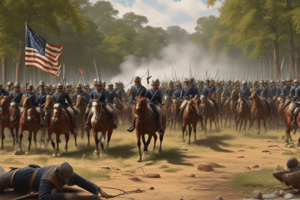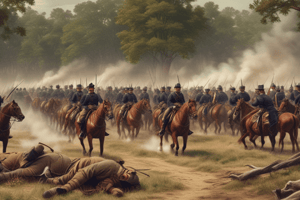Podcast
Questions and Answers
What event is considered the first major battle of the American Civil War?
What event is considered the first major battle of the American Civil War?
- Battle of Antietam
- First Battle of Bull Run (correct)
- Battle of Shiloh
- Battle of Gettysburg
Which event directly preceded the secession of Southern states?
Which event directly preceded the secession of Southern states?
- The attack on Fort Sumter
- The First Battle of Bull Run
- Abraham Lincoln winning the presidential election of 1860 (correct)
- The formation of the Confederate States of America
What action initiated the start of the Civil War?
What action initiated the start of the Civil War?
- The Confederate attack on Fort Sumter (correct)
- The Union's blockade of Southern ports
- The First Battle of Bull Run
- Lincoln calling for troops to defend the Union
What geographic feature was near the location of the First Battle of Bull Run?
What geographic feature was near the location of the First Battle of Bull Run?
Who was the Confederate General who earned the nickname "Stonewall" at the First Battle of Bull Run?
Who was the Confederate General who earned the nickname "Stonewall" at the First Battle of Bull Run?
Flashcards
First Battle of Bull Run
First Battle of Bull Run
The first major battle of the American Civil War, fought on July 21, 1861. It resulted in a Confederate victory and demonstrated the war would be longer and bloodier than anticipated.
Confederate States of America
Confederate States of America
Following the secession of Southern states after Lincoln's election, these states formed the Confederate States of America in February 1861.
Anaconda Plan
Anaconda Plan
Lincoln's initial strategy, proposed by General Winfield Scott, aimed to blockade Southern ports and control the Mississippi River to slowly weaken the Confederacy.
Stonewall Jackson
Stonewall Jackson
Signup and view all the flashcards
Army of the Potomac
Army of the Potomac
Signup and view all the flashcards
Study Notes
- The First Battle of Bull Run was the Civil War's first major battle, fought on July 21, 1861.
- Approximately 60,000 men gained their first combat experience at Bull Run.
- Bull Run resulted in a Confederate victory that halted the initial Union attempt to capture Richmond.
- The battle highlighted that the war would be longer and bloodier than initially anticipated.
Background
- Southern states seceded after Abraham Lincoln's 1860 election, forming the Confederate States of America in February 1861.
- Lincoln faced the secession crisis upon inauguration on March 4, 1861.
- Lincoln believed secession was illegal but feared aggressive action would push more states to secede.
- Fort Sumter in Charleston became a key test when its commander, Major Robert Anderson, refused to surrender to Confederates.
- Lincoln's decision to resupply Fort Sumter led to Confederate forces firing on the fort on April 12, 1861, marking the start of the Civil War.
Ramping Up the War Effort
- The Confederate attack on Fort Sumter prompted Lincoln to call for 75,000 troops to defend the Union.
- Four more states, including Virginia, seceded following Lincoln's call for troops.
- Due to Baltimore's pro-secessionist sentiments, Lincoln sent troops to maintain order and keep Maryland in the Union.
- The Union army in Washington became the Army of Northeastern Virginia, commanded by Brigadier General Irvin McDowell.
- McDowell organized the army into divisions and provided basic training.
Confederacy's Response
- After Virginia seceded, the Confederacy moved its capital to Richmond.
- Confederate President Jefferson Davis organized a military, believing secession was legal, and authorized recruiting 600,000 volunteers by May.
- The Army of the Potomac was positioned near Manassas Junction, Virginia, under Brigadier General P.G.T. Beauregard.
- A second army, the Army of the Shenandoah, was organized at Winchester, Virginia, commanded by Brigadier General Joseph E. Johnston.
Strategic Advantages
- The South had a strategic advantage by being on the defensive, requiring the Union to invade Confederate states to end the rebellion.
- The North had advantages in population size and industrialization, allowing for larger armies and better supply capabilities.
- General Winfield Scott proposed the Anaconda Plan, which blockaded Southern ports and seized the Mississippi River to weaken the Confederacy.
The First Battle of the Civil War
- By early July, McDowell had 35,000 soldiers, facing pressure to attack Beauregard.
- Lincoln told McDowell, "You are green, it is true, but they are green also; you are all green alike."
- McDowell's army marched towards Manassas Junction on July 16, aiming to defeat Beauregard before Johnston's army could assist.
- Johnston moved his army by train to assist Beauregard after realizing the Union army to his north posed no threat.
- The Union and Confederate armies were evenly matched by the time McDowell was ready to attack.
Location
- The First Battle of Bull Run occurred near Bull Run Creek and Manassas Junction, west of Centreville, Virginia.
- The location was strategically important due to the junction of two railroads, controlling the movement of supplies and men.
- Beauregard and Johnston defended Manassas Junction along Bull Run to prevent the Union Army from crossing.
- McDowell aimed to seize the junction for a campaign to capture Richmond.
- The battle is also known as the First Battle of Manassas due to the Confederate practice of naming battles after nearby towns or junctions.
How the Battle Started
- On July 21, General McDowell sent two divisions to cross Bull Run at Sudley Springs Ford to attack the Confederate left flank.
- The rest of the Union Army demonstrated in front of Confederate positions at the Stone Bridge and Mitchell's Ford to distract Beauregard.
- At 5:30 A.M., Union artillery opened fire on Confederate positions at the Stone Bridge.
- Colonel Nathan Evans shifted most of his men to counter the main Union threat coming from the left flank.
- The Union march to Sudley Springs was delayed until 9:30 A.M., allowing Evans to establish a defensive position on Matthews Hill.
- Despite support from Brigadier General Bernard Bee and Colonel Francis Bartow, the Confederates were forced from the hill.
The Battle Turns
- General Thomas Jackson's Virginia brigade arrived and took a position on Henry House Hill.
- General Bee rallied his men by saying, "There stands Jackson like a stone wall! Rally behind the Virginians!". From that point on, Jackson was referred to as "Stonewall."
- The Confederate line on Henry House Hill caused a delay, allowing more Confederate troops to arrive.
- The battle moved back and forth across the hill until a Confederate counterattack on the Union's right flank gained an advantage.
- Exhausted and inexperienced Union soldiers retreated in panic, leading to a rout by 4:00 P.M.
Aftermath
- The Confederate armies were unable to pursue the routed Union Army.
- The Union Army's disorganization caused fear of a Confederate attack in Washington.
- The South celebrated the victory, hoping for foreign alliances.
- The North realized the war would be more difficult and bloodier than expected.
Casualties
- First Battle of Bull Run casualties:
- Union: 480 killed, 1000 wounded, 1200 missing, 2680 total.
- Confederate: 390 killed, 1600 wounded, 12 missing, 2002 total.
- About 28,400 Union and 30,800 Confederate soldiers participated in the battle.
- McDowell lost 9.5% of his force, while Beauregard and Johnston lost 6.5%.
- The casualties made the nation realize the realities of the conflict.
Next Steps
- Lincoln signed a bill to recruit 500,000 more men for three-year enlistments.
- General McDowell was replaced by Major General George B. McClellan, who reorganized and trained the army.
- The reorganized army was renamed the Army of the Potomac and was much larger in the Spring of 1862.
- Jefferson Davis called up another 500,000 volunteers for three-year enlistments.
- Joseph Johnston commanded the Confederate army until he was wounded and replaced by Robert E. Lee in May 1862.
- The Confederate army became known as the Army of Northern Virginia.
- Stonewall Jackson became Lee's important corps commander.
Studying That Suits You
Use AI to generate personalized quizzes and flashcards to suit your learning preferences.




